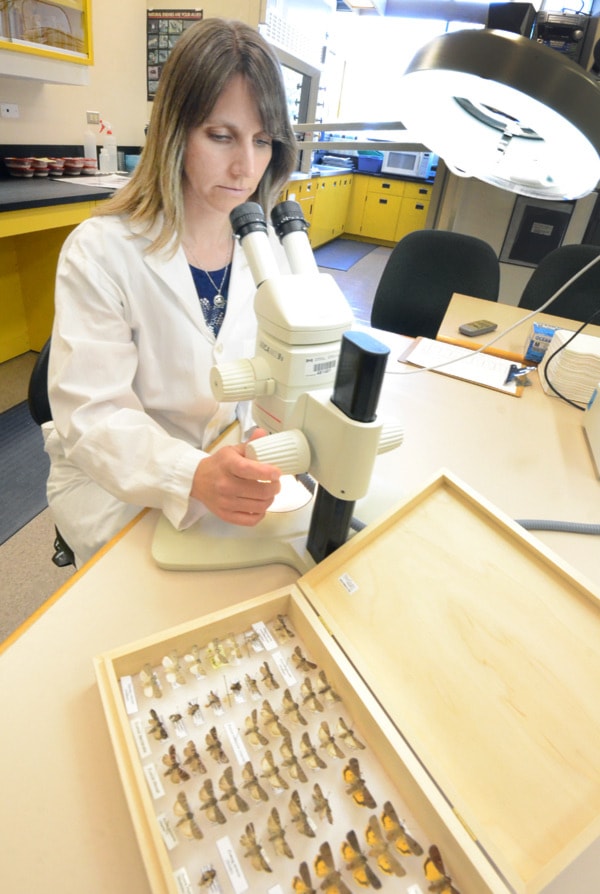For over 100 years what is now the Pacific Agri-Food Research Station has been a growing concern.
The work that has been done at the centre during that time has had an impact on agriculture around the globe ranging from pest control to species development and refinement.
 The Summerland Research Station actually started out in 1909 when Sydney Fisher, the then federal minister of agriculture, visited Summerland at which time officials J.M. Robinson, H.C. Mellor and MP Martin Burrell urged him to set up an experimental farm in the area.
The Summerland Research Station actually started out in 1909 when Sydney Fisher, the then federal minister of agriculture, visited Summerland at which time officials J.M. Robinson, H.C. Mellor and MP Martin Burrell urged him to set up an experimental farm in the area.
“We started out with the idea of what could be produced here what can we grow here,” said Kenna MacKenzie, the current associate director of research, development and technology. “I mean think about it, we had livestock, we had vegetables, we had forage, we had all of that.
“Now we really specialize on the things that are highlighted for the region which are tree fruits and wine grapes. We’ve grown, they’ve (agricultural sector) grown and we’ve honed our talents to what fits with the industry.”
On Oct. 4, from 10 a.m. to 4 p.m. the Pacific Agri-Food Research Station (PARC) is celebrating its 100th anniversary with a special open house.
Scientists, technicians and field staff will be at the event to teach people about apples, cherries and more through interactive exhibits and activities. Guided field tours will also be available.
“It’s really kind of exciting because the centre has contributed to the local region, the agricultural community and we’ve grown with the community and we work very closely with industry I’m definitely excited about what we’re doing,” said MacKenzie. “Our partnership with the community has been really good over the years.”
The research station has been home to beef cattle, poultry, sheep and a Jersey cattle herd that set records for milk and butterfat production. Several branches of research were discontinued while the horticultural research expanded.
Today, the research station is best known for its fruit research, especially the development of the Spartan apple. Work on this variety began in 1924 and the commercial trial took place in 1936. The Spartan is a hybrid of the Macintosh and Newton apples.
Whether it’s the Spartan apple or the sterile insect release (SIR) program, over the past century PARC has contributed many innovations to help keep growers in the Okanagan, and across Canada, ahead of the curve. Today, PARC’s research professionals and staff focus their energy in three broad areas of expertise: horticulture and environment, crop protection, and food science and technology.
“Our research is really tied to what’s important to the industry. Also what we’re addressing here is certainly regional but it also has impact nationally and internationally,” said MacKenzie. “The SIR program began at the centre and now it’s the envy of many places in the world to have that area-wide pest management which then allows you to reduce pesticide influence and do things a little bit differently. I mean we have a lot of organic orchards because of that program.”
Current horticulture programs include the tree fruit breeding programs, wine grape research, and environment and resource management. Plant pathology, entomology and Minor Use pesticide programs are geared towards a variety of crops. Among the things the food science and technology group focuses on are research on food safety and quality.
The office and lab complex was constructed in 1984 at a cost of $23.8 million, including the equipment.
As well on Oct. 4, the popular on-site Summerland Ornamental Gardens, which celebrates its own centennial in two years, is joining in the festivities. They were designed in 1916 by Alf Aveson and Joseph Smith.
The gardens will open the historic superintendent’s house for tours, refreshments and a silent auction. In the gardens, interesting and informative guided tours of the xeriscape (water wise) garden - the largest in Canada - the welcome carden, highlights of the gardens and much more will be happening. Also a perennial plant sale with some unusual plants for fall plantings with expert advice on plant selection and planting instructions if desired.
“We also do a lot in the area. In the last two years we’ve had 32 workshops and seminars and we are also doing a special program with school children, led by our master growers, the elders, and they grow their own vegetables and prepare food out of them,” said Eva Antonijevic, community outreach coordinator for the Friends of the Gardens Society which runs the operation.
